Spread Footing
Spread footing is a type of foundation system used to support an individual structure such as column, piers. Spread foundation are also known as pad footing and isolated footing. Design of spread footing are under a special diagram so that the entire structural load is easily transferred to a larger soil area, and it also reduces the pressure on the ground at a small area. Generally material used form constructed a spread footing are reinforced concrete. Base of this type of footing are wider so that the contact area of soil and footing are increased. Size and shape of this footing are dependent upon the different factor such as bearing capacity of soil, load to be supported and need of structures.
Spread footing are suitable for all type of construction industrial, commercial, and residential such as towers, malls, bridges, and buildings. The main purposes of constructed a spread foundation, to transfer all structural load to the soil in the manner way it means a designed way and ensure their safety and stability of the overall structure. By the transferred load for a larger area of soil and reduced the bear capacity of soil, thereby prevent the excess failure of soil. When these types of spread footing are designed some special points are also kept in the mind like an applied load of structure, soil bearing capacity and depth of stable soil or rock.
Notes – Spread footing in a type of foundation system to provide support for individual structure column, piers by distributing an equal load by the larger area of soil and ensure the stability and safety of structure or prevent the excess settlement of soil.
Types Of Spread Footing
There are different types of spread footing are used in construction and the selection of good type of spread footing are dependent upon the different factors such as load bearing capacity of soil or requirement of load and design structural configuration. Some common types of spread foundation are given below:
- Strip footing
- Pad footing
- Circular footing
- Stepped footing
- Combined footing
- Strap footing
Strip Footing
This footing is long and narrow shaped footing shown in below figure. Strip footing is supporting the line of columns or walls. When the load is distributed along the continuous line strip footing are used such as load bearing wall. The base of strip footing is wider and cover a wide area of soil and transfer the load to larger area.
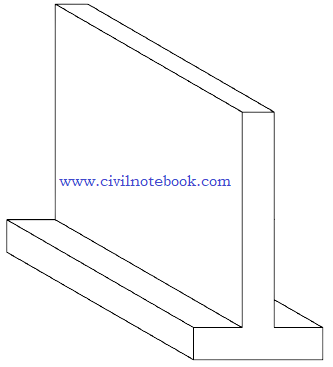
Pad Footing
Pad footing are square or rectangular in shape, so pad footing is also known as square footing or rectangular footing. Accordingly, to their shape square or rectangular load are distribute vertically over a large area. Pad footing are supported and transfer to the load individual columns. Generally, this type of footing is used in residential and small construction project.
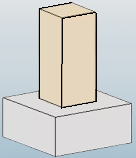
Circular Footing
This type of footing is circular shape. It supports the individual load and columns where preferred in circular shape. It is generally constructed where circular cross-section shaped are used, and this footing are transferring the load uniformly. Circular footing gives a better appearance.
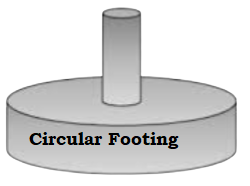
Stepped Footing
Stepped footing are also known as sloped footings. Stepped footing is used where their soil bearing capacity increase at the deeper levels. Having series of steps or tiers allowing to the wider base of footing accordingly to the greater depth.
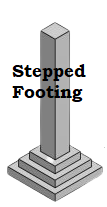
Combined Footing
When two or more than two columns are closed and overlap to each other, combined footing are used. In such cases combined footing are constructed to support multiple columns with shared footing that transfer the load over the large area.
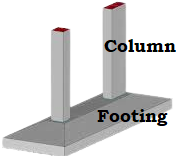
Strap Footing
If two or more than two columns are connected to each other by a concrete beam called as strap footing. Strap footing are also called as connecting footings. It is used when columns or isolated footing are closed and having uniformly load distribution of soil.
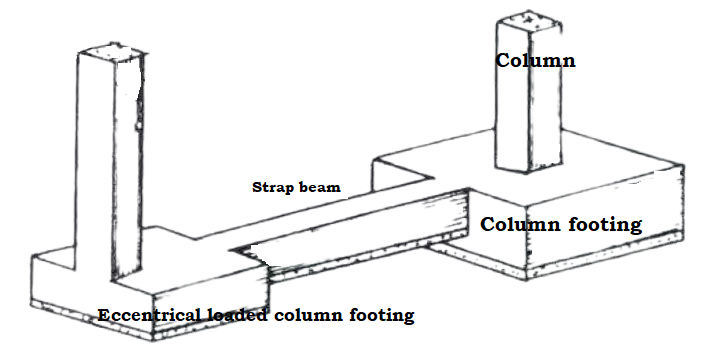
Advantages Of Spread Footing
- Spread footing have a wider base do it is effectively distributing the load from column or pier to the wider area of soil. And it provides greater stability for heavier structure.
- This footing is versatility and used for different types of construction including building, bridges, towers, and another heavier structure.
- Compare to another type of footing spread footing are cost effective option. Because it requires less excavation and material, and construction process of spread footing are easy do not require heavier equipment or techniques.
- This type of footing provide a structural integrity it means provides a solid and stable base for vertical structural elements by distributing the load evenly and ensuring withstand various loads and external forces.
- According to site requirement spread foundation provides a flexibility of construction, means shape and sizes. Construction flexibility allow for uses of space and desire load distribution.
- In spread footing easy to maintenance compared to another types of footing. Without any major wear and tear of the above structure easy to maintenance and repairs work are done.
- Spread footing are suitable for all type of soil either bearing capacity of soil is high or low. To the ensuring of long-term performance, stability or site requirement engineers can determine the appropriate size, depth, and reinforcement requirement for the footing.
In overall conclusion spread footing are cost effective and reliable option of other type of footing for supporting individual columns or piers. Above 7 points advantages of spread footing are making them ideal choice of different types of construction projects either projects are large or small.
Disadvantages Of Spread Footing
Spread footing have many advantages but another side it has some disadvantages of spread footing.
- Spread footing are dependent on the bearing capacity of soil to support of super structure with the help of column or pier. If the soil bearing capacity of change across to footprint, chances of uneven settlement and harm of structures. Such soil needs to improvement or specified foundation design.
- Spread footing have limited bearing capacity it means it suitable for supporting individual columns or piers, to the heavier load and large structure may not be ideal option. In cases where load is exceptionally heavy or large footprint of structure. In such cases deep foundation are used to distribute the load over a larger area of soil and structure provides satiability.
- Spread footing are required more excavation and construction material. Compare to another type of foundation system like raft or pile. Because Spread footing have wider base and wider base are required more soil excavation and more uses of concrete and reinforcement material. This can increase the cost of overall project.
- Spread footing have a limited resistance to lateral load. It provides a vertical load from columns or pier it has less resistance of lateral forces like wind load, seismic load.
- Impact on adjacent structure.
- Spread footing are designing process of spread footing are very complexity. When design of spread footing various factor is kept in the mind like a soil bearing capacity, structure load and settlement calculations. It also involves geotechnical investigations, soil testing. This process is increasing cost and design complexity.




Pingback: Design of spread footing - civilnotebook.com
Special offer for antibiotics: buy antibiotics no prescription and get discount for all purchased! Two free pills (Viagra or Cialis or Levitra) available with every order. No prescription required, free delivery.
what ?